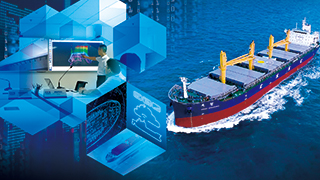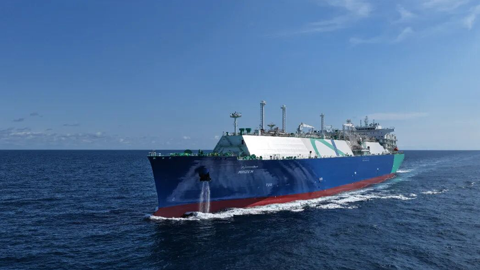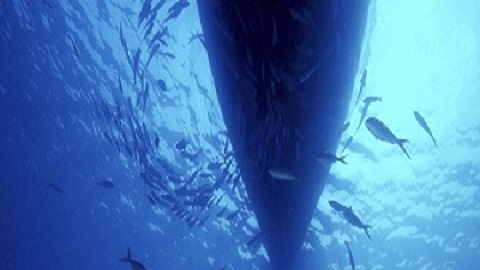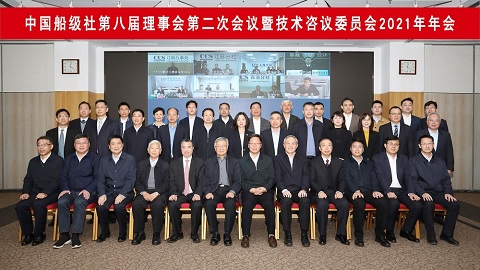By Jian Yanjun, CCS Shanghai Rules & Research Institute

The focus on ship emission reduction has gradually shifted from the improvement of ship energy efficiency to the safety, technology maturity, availability and economy of green and low-carbon alternative energy; the carbon emission market- based mechanism based on full life cycle has also become a current hot spot in the industry; the development of green and low-carbon ships is blooming .
I. Realization path and technical analysis of green and low-carbon ships
Based on technical analysis, carbon emission reduction can be achieved from three aspects, i .e . , the ship itself, fuel and after-treatment, which correspond to the adoption of energy- saving and efficiency-enhancing technologies, the application of green low-carbon fuels, and the application of shipboard carbon capture and after-treatment technologies . Therefore, based on the carbon emission market-based mechanism, emission-reduction performance modes can be divided into three types:firstly, using traditional fuels on the basis of meeting mandatory emission reduction requirements through energy-saving and efficiency-enhancing technologies, and paying excess carbon emission fees to meet deep emission reduction requirements;secondly, applying green low-carbon/zero-carbon fuels to solve the carbon emission problem at the energy end; and thirdly, using shipboard carbon capture chnologies to capture the carbon dioxide generated during the operation of the ship and transfer it to the shore for storage or utilization, so as to reduce the emission of carbon dioxide from the ship into the atmosphere and achieve the goal of deep emission reduction .
For the ship’s own energy-saving and efficiency-enhancing technologies, whether they are the light weight and propeller matching optimization used to improve navigation efficiency,or the air layer drag reduction, coating drag reduction and line optimization used to reduce navigation resistance, or the optimization of power units and use of auxiliary energy sources such as wind and solar energy, they are all relatively mature and have been widely applied . Although the emission reduction effects of such technologies may be restricted by factors such as the ship type, size, and route, the combination of multiple such measures may still not be sufficient to achieve the accumulation of the emission reduction effects, and the emission reduction potential is limited, they solve the urgent need of the industry in its coping with EEDI 3 and the mandatory requirements of CII before 2026. However, it is still difficult to meet the requirements for deep emission reduction after EEDI Stage 3 with those technologies alone . Therefore, the application of green and low-carbon alternative energy and shipboard carbon capture technology is gradually becoming a current hot spot in the industry’s emission reduction path .
LNG is the earliest and most widely used alternative fuel,and basically, relevant key technologies have been developed for the whole process from storage, transportation, bunkering to combustion on board . However, using LNG as a ship fuel,there are also disadvantages such as inconvenient refueling and storage, large price fluctuations, methane slip, and limited potential for emission reduction . In the context of the shipping industry's carbon neutrality requirements, it is difficult for the LNG fuel itself to undertake the task of emission reduction .
For the methanol fuel, after nearly 10 years of use on ship,the industry has accumulated relatively rich experience, the relevant legal system has basically been established, and the ship power system based on methanol fuel is relatively mature .Moreover, there are many ways to produce methanol, having many advantages such as mature production process, abundant raw materials, large production capacity, well developed logistics chain, and high availability . In addition to producing methanol from biomass, green methanol can also be obtained by the synthesis of carbon dioxide and green hydrogen that is produced from renewable energy such as wind energy and solar energy, which provides a way for carbon dioxide resource utilization by shipboard carbon capture and also makes it possible for the shipping industry to achieve carbon neutrality and net zero emissions by itself.
As for ammonia, its biggest feature is that it does not produce carbon dioxide when burned on board, and its production does not require a carbon source and can achieve zero carbon emissions throughout the life cycle based on green electricity only . However, the volumetric energy density of ammonia is very low, and it needs to be liquefied and stored at low temperature; compared with fuel oil for ships, nearly 4 times of fuel tank capacity is needs for the same voyage; it has strong corrosivity and toxicity; there is a lack of experience in the use of it as a fuel for ships, there is a gap in the regulatory system for its shipboard application, and its industry chain related to ship power systems and refueling is still very immature . At the same time, for ammonia to be used as a fuel,the energy conversion efficiency of its production is relatively low (less than 50%), and the energy loss in its storage and transportation is high (more than 10%), while for the ammonia produced based on fossil fuels, the carbon emissions in its entire life cycle is higher than that of traditional fuels . In general, there are still great challenges in the application of the ammonia fuel on ships .
As a fuel, hydrogen can achieve zero pollution and zero emissions; the hydrogen production process by electrolysis of water is mature; the hydrogen produced by green electricity is a renewable and clean energy . However, as the substance with the smallest molecular weight, it is easy to escape, with the widest range of deflagration . In addition, the volumetric energy density of hydrogen is extremely low, less than 0 .3% of diesel for ships;even if it is stored on board under a 70 MPa high pressure or a -253°C liquefaction mode, its volumetric energy density is still less than 12% and 23% of diesel for ships . Furthermore,whether it is pressurized or liquefied, the requirements for storage tanks are both extremely high . Hydrogen fuel cells for ships still have the disadvantages of low single-unit power,high cost, and short life, while high-power hydrogen internal combustion engines are still in the early stage of research and development . Based on the characteristics of hydrogen fuel, the storage and transportation conditions, and the maturity of power units, it is difficult to be used as the primary fuel on large ships and ocean-going ships .
CO2 capture, utilization and storage (CCUS) refers to the process of separating CO2 from industrial production,from energy use or from the atmosphere, and then using it directly or injecting it into the formation to achieve permanent reduction of CO2 emissions . As a strategic technology that is expected to realize the large-scale low-carbon utilization of the fossil energy, CCUS has the potential to significantly reduce greenhouse gas emissions in the entire life cycle of the traditional fossil energy and realize the negative carbon emissions of green energy, and has been widely used in onshore industries such as electricity, energy, cement, and chemical engineering . Although shipboard carbon capture technology currently still has obstacles such as relatively high energy consumption, lack of experience in shipboard use, difficult layout of storage space for captured CO2 ,insufficient supporting infrastructure for CO2 transfer and offloading, lack of emission reduction approvals, and lack of emission reduction recognition and regulations for shipboard use, when the ship adopts the carbon capture technology for ship exhaust, it can be integrated with desulfurization and denitration post-treatment, which basically does not change the ship’s conventional power system layout, and flexibly achieves the carbon reduction target by adjusting the CO2 capture rate, it has great potential for emission reduction, and it is being highly valued by all relevant parties in the industry at home and abroad, with many shipyards and design units cooperating with system equipment manufacturers to carry out research and development of new ship types for shipboard carbon capture systems .


II. Future outlook
Going green and low-carbon, energy saving and emission reduction are the major trends in the development of the shipbuilding industry and shipping industry . In order to meet the increasingly strict emission reduction requirements,under the traditional energy-saving and efficiency-enhancing measures, green and low-carbon energy and shipboard carbon capture technology will be gradually introduced, definitely .
LNG power has a mature industrial chain and high availability, but it is restricted by its limited emission reduction potential and relatively poor economy, and will only be used as transitional fuel for the shipping industry towards net zero emissions, unless used in conjunction with the shipboard carbon capture technology
For methanol power, although it is limited by its volumetric energy density, and needs to be equipped with a relatively large fuel tank, but its liquid storage conditions are normal temperature and pressure and hence are conducive to the layout of the fuel tank . Moreover, the combination of green,blue and gray methanol can flexibly achieve emission reduction targets at different stages, and can also reduce fuel costs . As world-renowned shipowners continue to place orders for the construction of methanol dual-fuel ships, the infrastructure of the methanol fuel supply chain for ships will gradually be built and improved, and methanol power devices/systems will be further enriched in kinds and reduced in construction costs,methanol will gradually become the main path for international shipping towards net zero emissions .

Ammonia power has very good emission reduction potential, but it has many disadvantages, for example, low volumetric energy density, low temperature for storage,immature power industry chain, lack of regulations and rules,relatively poor economy brought by high energy consumption in production, toxicity and lethality; hence, it is difficult to be popularized and applied in the shipping industry in the short term, and it will only be a potential choice for some ship types that are not sensitive to cabin capacity (for instance, VLOC) in the future .
For hydrogen power, although it can achieve zero carbon emissions in the whole life cycle, yet due to its extremely low volumetric energy density, it is difficult to be directly used as the primary energy source for propulsion on large ocean-going ships before breakthroughs in low-cost, high-capacity, safe and reliable hydrogen storage technologies have been achieved . In addition, there are still many difficulties in the application of hydrogen on board of a ship, such as incomplete regulations,lack of refueling infrastructure, and lack of low-cost and high power units .
For the shipboard carbon capture technology, the relevant regulations, rules and CO2 transfer infrastructure have yet to be improved, but its strong emission reduction potential, lexible matching with emission reduction targets and good economy have gradually attracted the attention of the industry . Domestic and foreign investment on the research and development of related technologies is increasing; moreover, its coupling with the green methanol production industry can realize the carbon cycle between onshore production and shipboard use to achieve net zero emissions . Therefore, the shipboard carbon capture technology will also be a very competitive technical path for international shipping to achieve carbon neutrality .
For the shipbuilding and shipping industry, there is no end to be “green” and no stop in “emission reduction” . In the future,there will be a new round of competition around green ships design, green key technology research, green ships supporting optimization, and core equipment independence .
Note: If you need to reprint, please indicate the source of the information.













